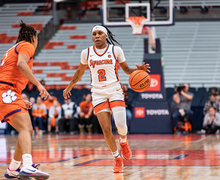Salazar: Snapchat give users privacy, lacking on other social media
Last week, Snapchat users were given an update that included some new features, and took some old ones along with it. Most notably, the app now allows users to look at content from featured media like National Geographic, Cosmopolitan and ESPN. While consumers can now receive a wider variety of content, Snapchatters no longer have access to view their contacts’ best friends. With the new upgrade, stalkers and jealous girlfriends grieved alike.
Although social media users share much of their lives on these outlets, there still exists a push for privacy.
With over 100 million active monthly users and roughly 400 million snaps sent a day, Snapchat’s success reflects our generation’s belief that people truly care what we are doing. Yet the company’s recent changes remind us that as users of this of social media, we deserve some privacy.
Snapchat’s most prominent features include the ability to see who has opened your snaps, along with who has screenshotted your content. Unlike Facebook, Instagram or Twitter, once a photo or video is gone, it is irretrievable. Snapchat’s success rests on the fact that it gives users more freedom to snap without constraint and allows for more honest consumption.
Websites like Facebook and LinkedIn have major influence in terms of career and educational opportunities. Those profiles can be easily found through Google searches. While it is important to consider that these sites inform users about their privacy rights and terms and conditions, it does not mean that millennials do not have the right to seek more discrete sharing elsewhere. While the likes of Facebook, Twitter and Instagram do not filter out the same activity, with Snapchat users have access to private interaction.
Snapchat is not free from criticism. The app contains flaws like any other social media outlet. It was discovered that Snapchat on Android phones did not permanently delete photos but rather photos were hidden and could be retrieved through complex computer software. Also just because one can see if someone screenshots his or her content, does not mean it will stop others from doing it.
Without a doubt, many realms of social media contain flaws. The activity feeds on Instagram and Facebook that allow users to see what others like and comment on invade the privacy of others. Removing the ability to view other people’s best friends establishes more mobility for users. In a time where nothing is left undocumented, we deserve to post without consequences.
While there have been reported cases of cyber bullying on Snapchat, it can still be a space where freedom can create more conscious consumption. Considering that the majority of the demographic are teenagers and young adults, with 71 percent of users under 25, the app appeals to younger consumers because it does not create fear of permanence with its posts.
The concealment of best friends might seem like a small change, but it speaks to our generation’s desire to socialize without the eyes of Big Brother. Although asking for privacy on social media might seem hypocritical, it needs to be established that using realms of social media does not mean people need to reveal all their personal interactions. If we are to admit we are a flawed generation, then we do not need all forms of media to reveal everything we do. Privacy does not necessarily equate to secrecy, but it gives consumers more social mobility to interact freely with others in the absence of judgment or consequence. Snapchat’s success is accredited to its appeal to its demographic by giving people the ability to interact privately on social media.
Laritza Salazar is a sophomore newspaper and online journalism major. Her column appears weekly. She can be reached at [email protected].
Published on February 3, 2015 at 12:15 am




